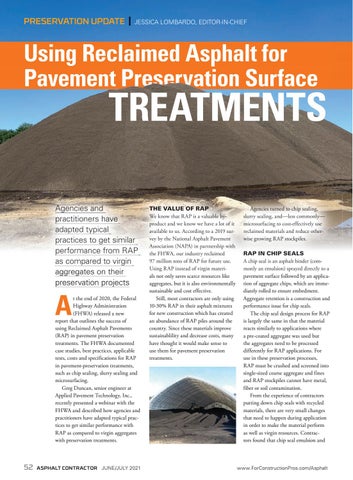PRESERVATION UPDATE |
JESSICA LOMBARDO, EDITOR-IN-CHIEF
Using Reclaimed Asphalt for Pavement Preservation Surface
TREATMENTS
Agencies and practitioners have adapted typical practices to get similar performance from RAP as compared to virgin aggregates on their preservation projects
A
t the end of 2020, the Federal Highway Administration (FHWA) released a new report that outlines the success of using Reclaimed Asphalt Pavements (RAP) in pavement preservation treatments. The FHWA documented case studies, best practices, applicable tests, costs and specifications for RAP in pavement-preservation treatments, such as chip sealing, slurry sealing and microsurfacing. Greg Duncan, senior engineer at Applied Pavement Technology, Inc., recently presented a webinar with the FHWA and described how agencies and practitioners have adapted typical practices to get similar performance with RAP as compared to virgin aggregates with preservation treatments.
52
ASPHALT CONTRACTOR JUNE/JULY 2021
ACON0621_52-53_Pres_JD.indd 52
THE VALUE OF RAP We know that RAP is a valuable byproduct and we know we have a lot of it available to us. According to a 2019 survey by the National Asphalt Pavement Association (NAPA) in partnership with the FHWA, our industry reclaimed 97 million tons of RAP for future use. Using RAP instead of virgin materials not only saves scarce resources like aggregates, but it is also environmentally sustainable and cost effective. Still, most contractors are only using 10-30% RAP in their asphalt mixtures for new construction which has created an abundance of RAP piles around the country. Since these materials improve sustainablility and decrease costs, many have thought it would make sense to use them for pavement preservation treatments.
Agencies turned to chip sealing, slurry sealing, and—less commonly— microsurfacing to cost-effectively use reclaimed materials and reduce otherwise growing RAP stockpiles. RAP IN CHIP SEALS A chip seal is an asphalt binder (commonly an emulsion) sprayed directly to a pavement surface followed by an application of aggregate chips, which are immediately rolled to ensure embedment. Aggregate retention is a construction and performance issue for chip seals. The chip seal design process for RAP is largely the same in that the material reacts similarly to applications where a pre-coated aggregate was used but the aggregates need to be processed differently for RAP applications. For use in these preservation processes, RAP must be crushed and screened into single-sized coarse aggregate and fines and RAP stockpiles cannot have metal, fiber or soil contamination. From the experience of contractors putting down chip seals with recycled materials, there are very small changes that need to happen during application in order to make the material perform as well as virgin resources. Contractors found that chip seal emulsion and
www.ForConstructionPros.com/Asphalt
5/25/21 9:55 AM







